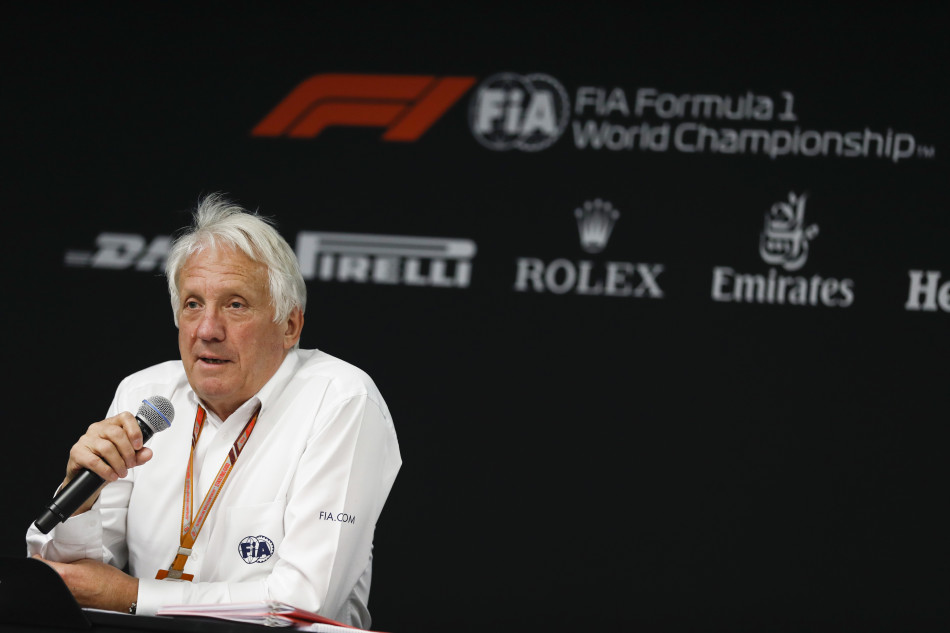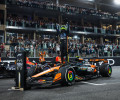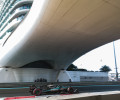FIA Formula One Race Director Charlie Whiting Press Briefing Transcript
FIA Formula One World Championship Australian Grand Prix
FIA Formula One Race Director Charlie Whiting Press Briefing Transcript

QUESTIONS FROM THE FLOOR
Q: (Ben Edwards – Channel 4) Charlie, do you have a Deputy Race Director in the end this weekend? If so, who, and can you the meeting without one effectively?
Charlie WHITING: I think we’ll be fine. We’ll be looking for a new person to take Laurent’s place, but that’s not the work of a moment. All we need to do, I think, in the immediate future, for the next few races, is simply to make sure we are covered sufficiently to fulfill all the tasks we have to do in Race Control, even at the busiest times. So we have people within our own ranks or especially here in Australia we have a very good team locally here, so we can call on a number of people to help out as and when necessary. As we did when Marcin Budkowski left, it took us some months to find Nikolas but we’ve now got a good guy, but we want to make the right choice.
Q: (Mariana Becker – TV Globo) Charlie, would you mind explaining a little bit more about the restarts without the Safety Car and if you’re going to use the Safety Car in any situation.
CW: You’re referring to restarting a race, if you have a red flag during a race. Now, as you are aware, prior to this we always brought the safety car in after a few laps or one or two laps if it was dry but if it was wet it typically might be a few more laps and then the Safety Car would come in and the cars would do, effectively, a rolling start. What we’re doing now is a standing start in its place. So the Safety Car will do a number of laps depending on the circumstances. It will come in and the drivers will come back to the grid and do a standing start. We do have the facility to make a decision on that last lap, when we decide to bring the Safety Car in we could say it’s going to be a rolling start or a standing start. We’ll make that decision at the end of the first sector. Those decisions will normally be based on obviously the track conditions, we may think it’s not quite good enough to do a standing start but we don’t want to do any more laps and we’ll just get them going with a rolling start. That’s an option that is open to us.
Q: (Ben Edwards – Channel 4) Just to clarify that – that is only after the stopped, red flagged, and then go into that procedure. If you have a Safety Car that comes out during a race, because of a yellow flag somewhere, that’s standard, you just carry on?
CW: That’s standard. Nothing has changed on that.
Q: (Christian Menath – Motorsport-magazin.com) Charlie I’ve got two questions on the start. First of all, today in the Race Director’s notes, you wrote that after FP1 and FP2 there are some practice starts, because the position of the starting lights has been a bit changed. As far as I understand there is a new standard for this position now. Is it because of the Halo?
CW: Yes, it’s principally because of the Halo. We haven’t normally allowed practice starts on the grid here because it’s tight timetable and things like that. With the Halo what we’ve asked every circuit to do is to make the lights at a standard height above the track and we’ve also put a repeat set of lights, on this case to the left, which you’ve probably seen, over the verge. Those repeat lights were normally half way up the grid and they were fitted around 2009 when the rear wings became higher on the cars. Some drivers complained about not being able to see the main start lights, so that’s when we introduced an extra set. But now the wings have been lowered there is no need for those half way up the grid, so I’ve decided to utilise them somewhere else, so if, for example, is in pole position, and pole position of course appears to be the worst case scenario with the Halo there, maybe the driver can’t quite see the lights or see only half of them and he might have to move his head too much, then he has a repeat set of lights, which are 5 metres further down the track. So what I though it would be a good idea to do would be to give the drivers sight of those lights rather than have them look at them for the first time on Sunday evening.
Q: (Christian Menath – Motorsport-magazin.com) And second question: are you concerned, because we’ve seen some cars smoking heavily when they run out of the garage or starting from the pit lane, that some drivers might not see the lights as well as some others?
CW: I don’t think there’s any reason to suppose that the smoke that you saw in a couple of the garages in Barcelona is going to be like that - certainly not on the grid anyway. Last year, there were a couple of cars that seemed to belch out a lot of smoke when they started in the garage but it seldom manifested itself on the grid.
Q: (Julien Billiotte – Auto Hebdo) Going back to the topic of Lauren Mekies’ departure from the FIA. Some teams have expressed concern, if not anger, that another senior FIA official is leaving the Federation for a team. Should there be stricter gardening leave periods, stricter regulations, do you understand their concerns and could it be enforced?
CW: I can understand why some teams might be a little upset. But I think the sort of information that Laurent had available to him was somewhat less sensitive than Marcin. I’ve not actually heard any team complain to me about it. I’ve read a few stories but no team has actually has approached me and expressed displeasure about it. Maybe when we meet in a couple of weeks’ time with all the teams it might come about it. After Marcin left there was quite a bit of discussion about this in the Strategy Group and the Formula 1 Commission, as you may have heard, and certain guidelines were suggested and things are still being worked on with the relevant teams and with our legal people to see what can be done within the law in various countries. That’s still work that is ongoing.
Q: (Tony Dodgins – Channel 4) Charlie, there is a third DRS zone here and I think the delta for overtaking is almost two seconds. Is that planned to happen at other tracks and can you tell us where?
CW: We’re just looking at trying to optimise or maximise what can be done with the DRS. This is not an ideal circuit for that, as you know. The two DRS zones we have now are not particularly effective and we just thought there is an opportunity to do something on that stretch between Turns 12 and 13, and if a driver can get a little closer than he otherwise may have done he may then get detection at Turn 14, which would allow him to use it on the two stretches here. It was just to offer a little something else. But we will try to do something more effective at other tracks where there is more opportunity to do that.
Q: (Adam Cooper – Motorsport.com) We talked about Laurent in terms of the Race Director job, but what about the loss in terms of the safety side, all the work he is doing and all of a sudden he is not there?
CW: He is still there, first of all, but once he works out his period of notice but of course we need someone to replace him as the FIA Safety Director as well.
Q: (Mike Doodson – Honorary) Charlie, I’m a simple soul who watches more than half the races on TV and talks to people down the pub. So I hope you’ll bear with me for my simple question, which is that it seems to me that the limitation on the number of engines permitted is in fact self-defeating if the objective is to save the teams money, because if they do blow up an engine, it costs them an awful lot of money, which you’ll recognise to replace them. At the same time they get penalised with dozens of grid penalties which certainly don’t look good in the public eye. Would it not be more logical to enforce the regulation by actually excluding teams which fail to live up to the high standards you set on them?
CW: That’s a rather odd question, if I may say. The rules are that one driver can’t use more than three engines during a season, so that’s a rule that’s set, and it was four last season. It’s just been reduced. Yes, some people think that the regulation didn’t really need changed and it has induced more cost and it will cost more than its saving. But time will tell if that’s the case. I strongly suspect they have all done a brilliant job at it and they would have made their engines last longer and I think very little will change. On the penalties, you may be aware that one change that has been made this year is to put a cap on the number of grid place penalties that a driver can have, which is set at 15, and then the driver starts from the back of the grid. So that’s changed, so we won’t have any more of those 65-place grid penalties.
Q: (Christian Menath – Motorsport-magazin.com) There have been set some new rules for preventing oil burning of the engines. Still some teams think it is possible. How do you measure it, apart from the live telemetry you get, and are you 100% sure you can prevent them burning oil?
CW: As you said there are lots of new rules. There is a new specification of oil, which would prevent any combustion-enhancing material being used in the oil. We have approval of oils. They have to be pre-approved, as we have been doing with fuel for the past 20 years. The breather goes out of the back of the car rather than back into the intake. All those things, plus a 0.6l/100km limit on the oil consumption anyway. Some teams that have been saying that look we can measure it over a race distance, it’s easy to measure, but we won’t be able to tell anything in qualifying. So today, Nikolas sent a note to all the teams, asking them a few questions about their auxiliary oil tanks, which I think you’re all aware they have, whether they will be using them in qualifying and what are they going to do to satisfy us that these are not being used for used for any other reason… are they going to be used, first of all, and then how will they make sure that we are happy that we are happy they are not using any more than we think they are. Lots of separate questions. We are waiting for answers back to those questions and then we will examine each car to make sure that we are full satisfied that the oil usage they declare is accurate. So think that we have everything covered.
Q: (Andrew Benson – BBC Sport) Do you have any concerns about Haas in terms of the design of their car, and have any teams expressed their concerns to you about that?
CW: No and no. We know exactly what’s going on between Haas and Ferrari, which is completely legal. Last year we had one team expressing some concerns, but we’ve not seen anything that concerns us.
Q: (Ben Edwards – Channel 4) I just wanted to ask you about how the teams have incorporated the Halo? Are you happy with how that whole project has gone over the winter with the crash testing? And also, apart from the lights, is there anything else procedurally that would have changed because the Halo is now on the car?
CW: Yes, I’m personally pretty happy with the way it’s been incorporated into the cars and I think they look a good deal better than the ones that were being tested during the course of last year, but it’s only a personal view on that one. There are a few minor changes to the rules, which I’m sure you’re aware of, such as the cockpit exit time is two seconds longer than it used to be. I think it’s all going very well. Ian and Alan have been doing work with all the recovery teams and rescue teams and the extrication teams to make sure that everyone is fully trained to get a driver out of it in exactly the same way as without a Halo. So, I’m pretty sure we’ve got all bases covered there.
Q: (Mike Doodson – Honorary) In the Drivers’ press conference today, Lewis Hamilton may not have been joking when he said that to save a bit of weight he may not be painting his helmet in special colours, because the Halo actually obscures helmets. It also makes identification of the cars, which was already difficult, even more difficult. Is there something the FIA can do, perhaps by allowing different colours of Halos? And there was a suggestion by the President that the leader of the world championship’s Halo should be painted yellow, which I thought was a good idea. I wonder if there has been any progress on either of those?
CW: First of all, identification of the cars: I’ve always personally felt that it was much easier to try to look at the colour of the onboard cameras than it is to try to identify a driver. Max and Daniel, for example, look quite similar and especially last year it was much easier with those two cars because the numbers are very prominent, which they weren’t until last. I think you’ll agree that actually worked quite well. We’ve made sure that all the numbers are on the cars in exactly the same places and the cameras will be black for the first car and yellow for the second car. I’m fairly sure that fans won’t need to resort to try and identify drivers’ helmet colours to know who is in the car. On the yellow Halo: it was all very well until Renault pointed out that they would want theirs yellow anyway, so it died a death that one. It hasn't been discussed since then.
Q: (Carlo Vanzini – Sky Sports Italy) I would like to know if there will be a Deputy F1 Race Director after Mekies and when there will be start after Safety Car, if it will be standing start or rolling start or it will be your own decision?
CW: I take it you weren’t here at the beginning, I answered those questions earlier. The Safety Car procedure won’t change. It will only change if the race is stopped.
Q: (Inaudible) You mentioned that the extrication teams had planned or worked on the new situation with the Halo. Is there a chance to get any TV footage of that, because that’s obviously very interesting to television because it’s the first race with the Halo and we try to explain to our audiences what’s new and positive and what might be negative and pictures like that might help?
CW: Ian, maybe you could answer that it would be possible to release some video of the extrication exercises that were done in Le Mans I think.
Ian ROBERTS: There may be a possibility of some footage. Certainly it’s probably not going to be possible with the teams here, but I can look into it.
CW: But you can confirm that lots of extrication teams have already been trained in extricating a driver with a Halo.
IR: There was a training weekend carried out in Le Mans where extrication teams were invited to take part. All of the national extrication teams have worked very hard in terms of adapting their technique to the Halo. The FIA practice chassis has been adapted and it has a Halo in place and they have all be practicing with the Halo. There are some minor adaptations with the Halo, but generally speaking, it’s fairly common sense and just minor differences in technique really.
CW: Of course we should also point out that Halo will be on all Formula 2 cars, all Formula 3 Regional cars and from 2019 all Formula 3 cars in Europe as well. It’s not just an F1 thing that they are training for.
Q: (Dan Knutson – Auto Action and Speed Sport) The drivers all love the new cars, faster, but it’s the same old story, they all say ‘when I get too close to the car in front, I can’t follow’. Now what are you going to do long-term about this fundament problem that has existed for years and years?
CW: There is a programme being embarked upon, a joint venture between the FIA and FOM, for a 2021 car. Nikolas is heavily involved in that with a team from the Commercial Rights Holder, the idea being to develop a car that would be easier to follow than they have been in the past. It is a very tricky project; it’s not easy. If it were easy, it would have been done in the past. But it is in hand and that is one of the main goals for 2021.
Q: (Roberto Chinchero – Sky Sports Italy) Did you consider the possibility that the teams would be forced to reduce their track time during the free practice because of the three-engine rule?
CW: We’ll just have to see. I don’t think so, because they have all been telling me that they have doing a lot of work on durability. Obviously they want to do as much running as they can. I think engine saving has been with us for years, in one form or another. But they do need to get out there and test, of course. They’ve got plenty of tyres. We’ll see but I somehow think there won’t be any difference, because they’ve all been telling us how much they have been doing on making sure that the engines are more durable.
Q: (Ben Edwards – Channel 4) I noticed in the rules that they can use tyres that are not necessarily one set, after qualifying, they have to be from the same compound but they don’t have to be from the same set. What’s the reason for that rule change?
CW: The full rule change is that tyres now have to be used in sets, which they didn’t before. They had to be of the same compound in the past, but they didn’t have to be used as sets as allocated by ourselves. Now they do, except after qualifying when they can mix them.

 Facebook
Facebook Twitter
Twitter






